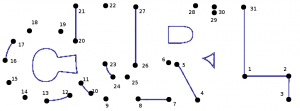Allow as much as possible and only sanitize what’s absolutely necessary.
That has basically been the rule for the URL parser in curl and libcurl since the project was started in the 90s. The upside with this is that you can use curl to torture your web servers with tests and you can handicraft really imaginary stuff to send and thus subsequently to receive. It kind of assumes that the user truly gives curl a URL the user wants to use.
Why would you give curl a broken URL?
But of course life and internet protocols, and perhaps in particular HTTP, is more involved than that. It soon becomes more complicated.
Redirects
Everyone who’s writing a web user-agent based on RFC 2616 soon faces the fact that redirects based on the Location: header is a source of fun and head-scratching. It is defined in the spec as only allowing “absolute URLs” but the reality is that they were also provided as relative ones by web servers already from the start so the browsers of course support that (and the pending HTTPbis document is already making this clear). curl thus also adopted support for relative URLs, meaning the ability to “merge” or “add” a relative URL onto a previously used absolute one had to be implemented. And even illegally constructed URLs are done this way and in the grand tradition of web browsers, they have not tried to stop users from doing bad things, they have instead adapted and now instead try to convert it to what the user could’ve meant. Like for example using a white space within the URL you send in a Location: header. Even curl has to sanitize that so that it works more like the browsers.
Relative path segments
The path part of URLs are truly to be seen as a path, in that it is a hierarchical scheme where each slash-separated part adds a piece. Like “/first/second/third.html”
As it turns out, you can also include modifiers in the path that have special meanings. Like the “..” (two dots or periods next to each other) known from shells and command lines to mean “one directory level up” can also be used in the path part of a URL like “/one/three/../two/three.html” which equals “/one/two/three.html” when the dotdot sequence is handled. This dot removal procedure is documented in the generic URL specification RFC 3986 (published January 2005) and is completely protocol agnostic. It works like this for HTTP, FTP and every other protocol you provide a path part for.
In its traditional spirit of just accepting and passing along, curl didn’t use to treat “dotdots” in any particular way but handed it over to the server to deal with. There probably aren’t that terribly many such occurrences either so it never really caused any problems or made any users hit any particular walls (or they were too shy to report it); until one day back in February this year… so we finally had to do something about this. Some 8 years after the spec saying it must be done was released.
dotdot removal
Alas, libcurl 7.32.0 now features (once it gets released around August 12th) full traversal and handling of such sequences in the path part of URLs. It also includes single dot sequences like in “/one/./two”. libcurl will detect such uses and convert the path to a sequence without them and continue on. This of course will cause a limited altered behavior for the possible small portion of users out there in the world who would use dotdot sequences and actually want them to get sent as-is the way libcurl has been doing it. I decided against adding an option for disabling this behavior, but of course if someone would experience terrible pain and can reported about it convincingly to us we could possible reconsider that decision in the future.
I suspect (and hope) this will just be another little change along the way that will make libcurl act more standard and more like the browsers and thus cause less problems to users but without people much having to care about how or why.
Further reading: the dotdot.c file from the libcurl source tree!
Bonus kit
A dot to dot surprise drawing for you and your kids (click for higher resolution)

